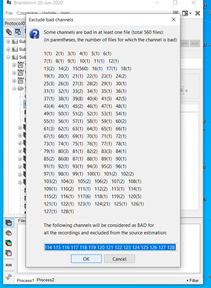Hi
I ran the below script to calculate sources for my subjects. After a few subjects the process stops due to one subject having no good channels. Some of the subjects listed in the report have numerous bad channels. I got the below messagein the MatLab command window. I have not marked any channels as bad and relied solely on ICA/SSP and removed channels +-100uv to deal with artifacts. I noticed on the forum someone else had this problem due to not calculating a noise covariance matrix. I have already calculated both noise and data covariance matrices. Can you advise what I should do?
% Script generated by Brainstorm (20-Jun-2020)
% Input files
sFiles = ;
% Start a new report
bst_report('Start', sFiles);
% Process: Select files using search query
sFiles = bst_process('CallProcess', 'process_select_search', , , ...
'search', '(([path CONTAINS "resample"] AND [name CONTAINS "WAvg:"]))');
% Process: Compute sources [2018]
sFiles = bst_process('CallProcess', 'process_inverse_2018', sFiles, , ...
'output', 1, ... % Kernel only: shared
'inverse', struct(...
'Comment', 'MN: EEG', ...
'InverseMethod', 'minnorm', ...
'InverseMeasure', 'amplitude', ...
'SourceOrient', {{'fixed'}}, ...
'Loose', 0.2, ...
'UseDepth', 1, ...
'WeightExp', 0.5, ...
'WeightLimit', 10, ...
'NoiseMethod', 'reg', ...
'NoiseReg', 0.1, ...
'SnrMethod', 'fixed', ...
'SnrRms', 1e-06, ...
'SnrFixed', 3, ...
'ComputeKernel', 1, ...
'DataTypes', {{'EEG'}}));
% Save and display report
ReportFile = bst_report('Save', sFiles);
bst_report('Open', ReportFile);
% bst_report('Export', ReportFile, ExportDir);
BST_INVERSE (2018) > NOTE: Cross Covariance between sensor modalities IS NOT CALCULATED in the noise covariance matrix
BST_INVERSE > Rank of the 'EEG' channels, keeping 116 noise eigenvalues out of 118 original set
BST_INVERSE > Using the 'reg' method of covariance regularization.
BST_INVERSE > Diagonal of 10.0% of the average eigenvalue added to covariance matrix.
BST_INVERSE > Using 'fixed' surface orientations
BST_INVERSE > Rank of leadfield matrix is 116 out of 118 components
BST_INVERSE > Confirm units
BST_INVERSE > Assumed RMS of the sources is 1.87 nA-m
BST_INVERSE > Assumed SNR is 9.0 (9.5 dB)
